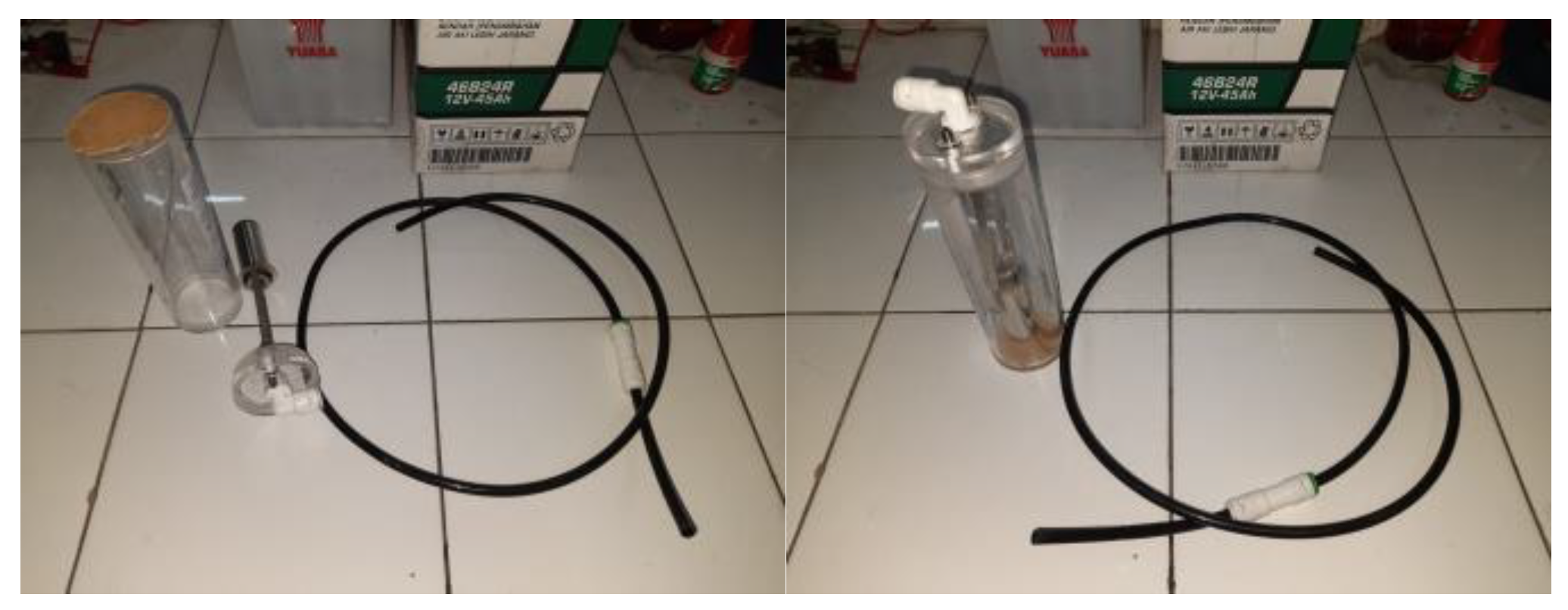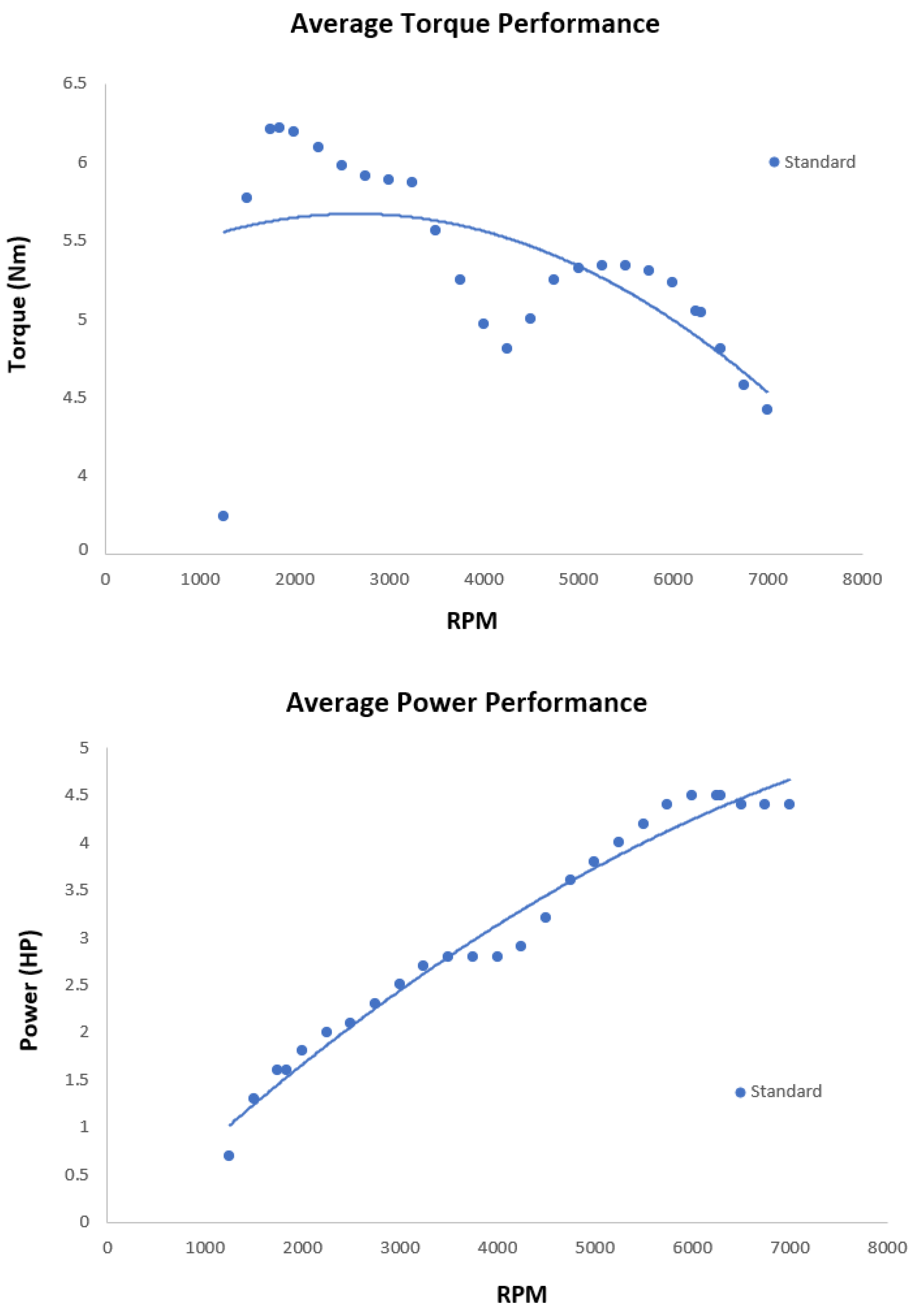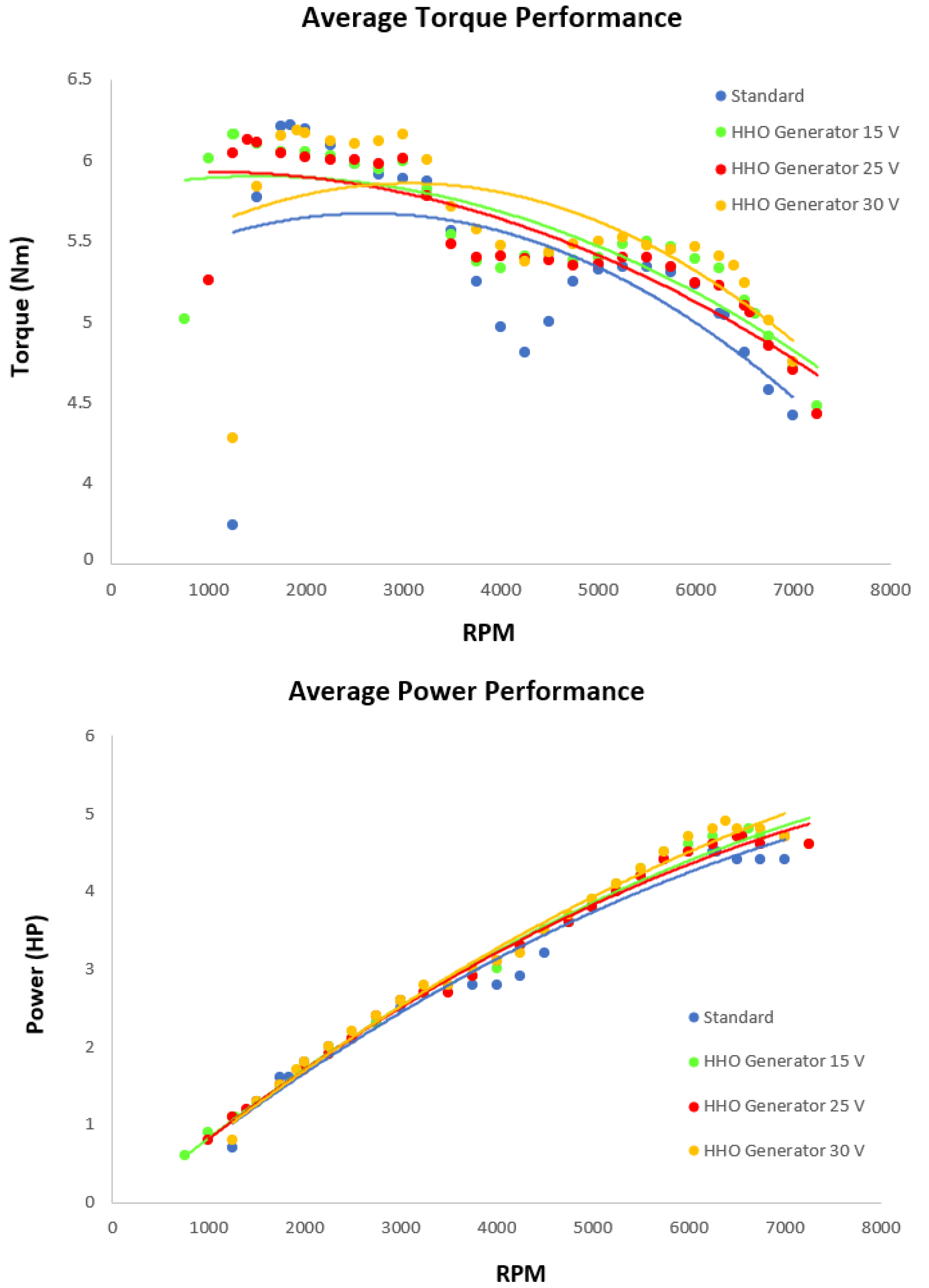Performance Assessment of Spark-Ignition Engine Combined with an HHO Generator †
Abstract
1. Introduction
2. Research Methodology
3. Results and Discussion
3.1. Base Engine Performance without HHO Generator
3.2. Performance Metric with HHO Systems
3.3. Theoretical and Actual Hydrogen Production Comparison
3.4. Fuel Consumption Analysis
3.5. Thermal Efficiency Evaluation
4. Conclusions
- In general, the difference in engine performance between having an HHO generator and not having one was not enough to be considered noteworthy. Some data indicated that vehicles operated without an HHO generator performed better. The utilization of local tap water, which is contaminated with a variety of pollutants that have the potential to influence the effectiveness of the electrolysis process in the HHO generator, could be the cause of this phenomenon. Future study could consider utilizing a medium that enhances electrolysis efficiency, like distilled water with an additional electrolyte, or investigating catalysts to improve the electrolysis process.
- The electricity source in this research was a power supply, which has space limitations, considering that the power supply requires electrical input from another source. It would be better if future studies were carried out with an automotive battery so that the mobility would be higher and more accurately describe the original situation in which the HHO generator is used in a vehicle.
- It is necessary to carry out experimental research with more detailed data collection methods, such as details of actual HHO gas production and emissions analysis. This is useful for providing comprehensive research based on validated data.
- Given that our engine performance results were not significant, that the data were not validated experimentally, and that some parameters lacked detail, the results of this study are more suitable as a simple illustration of the use of commercialized HHO generators for motorized vehicles.
Author Contributions
Funding
Institutional Review Board Statement
Informed Consent Statement
Data Availability Statement
Conflicts of Interest
References
- Riyadi, T.W.; Spraggon, M.; Herawan, S.G.; Idris, M.; Paristiawan, P.A.; Putra, N.R.; Silambarasan, R.; Veza, I. Biodiesel for HCCI engine: Prospects and challenges of sustainability biodiesel for energy transition. Results Eng. 2023, 17, 100916. [Google Scholar] [CrossRef]
- Sunaryo, M.; Efendy, S.; Kamarrudin, N.S. Pyrolysis of plastic waste as an alternative fuel in spark ignition engine. Int. J. Emerg. Trends Eng. Res. 2019, 7, 454–459. [Google Scholar] [CrossRef]
- Syawitri, T.P. A Review: The Effect of Operating Conditions and Thermal Management on The Performances of Metal Hydride Hydrogen Storage Tanks. J. Ilm. Tek. Mesin 2016, 17, 38–43. [Google Scholar] [CrossRef][Green Version]
- Naqvi, S.A.H.; Taner, T.; Ozkaymak, M.; Ali, H.M. Hydrogen Production through Alkaline Electrolyzers: A Techno-Economic and Enviro-Economic Analysis. Chem. Eng. Technol. 2023, 46, 474–481. [Google Scholar] [CrossRef]
- Paparao, J.; Murugan, S. Oxy-hydrogen gas as an alternative fuel for heat and power generation applications—A review. Int. J. Hydrogen Energy 2021, 46, 37705–37735. [Google Scholar] [CrossRef]
- Nabil, T.; Dawood, M.M.K. Enabling efficient use of oxy-hydrogen gas (HHO) in selected engineering applications; transportation and sustainable power generation. J. Clean. Prod. 2019, 237, 117798. [Google Scholar] [CrossRef]
- Kazim, A.H.; Khan, M.B.; Nazir, R.; Shabbir, A.; Abbasi, M.S.; Rab, H.A.; Qureishi, N.S. Effects of oxyhydrogen gas induction on the performance of a small-capacity diesel engine. Sci. Prog. 2020, 103, 0036850420921685. [Google Scholar] [CrossRef] [PubMed]
- Matienzo, J.R. An Evaluation of the Effect of HHO in Carburetor Automotive Engines in Road Conditions. Available online: http://rie.cujae.edu.cu/index.php/RIE (accessed on 14 December 2023).
- El-Kassaby, M.M.; Eldrainy, Y.A.; Khidr, M.E.; Khidr, K.I. Effect of hydroxy (HHO) gas addition on gasoline engine performance and emiss ions. Alex. Eng. J. 2016, 55, 243–251. [Google Scholar] [CrossRef]
- Subramanian, B.; Thangavel, V. Analysis of onsite HHO gas generation system. Int. J. Hydrogen Energy 2020, 45, 14218–14231. [Google Scholar] [CrossRef]
- Li, W.; Tian, H.; Ma, L.; Wang, Y.; Liu, X.; Gao, X. Low-temperature water electrolysis: Fundamentals, progress, and new strategies. Mater. Adv. 2022, 3, 5598–5644. [Google Scholar] [CrossRef]
- Zhang, H.; Su, S.; Lin, G.; Chen, J. Configuration Designs and Parametric Optimum Criteria of an Alkaline Water Electrolyzer System for Hydrogen Production. 2011. Available online: www.electrochemsci.org (accessed on 26 December 2023).
- Zhang, H.; Lin, G.; Chen, J. The performance analysis and multi-objective optimization of a typical alkaline fuel cell. Energy 2011, 36, 4327–4332. [Google Scholar] [CrossRef]
- Jannah, Z.; Susilo, S.H. Design of HHO generators as producers of water fuel (HHO generator product analysis based on electric current and catalyst). IOP Conf. Ser. Mater. Sci. Eng. 2021, 1073, 012034. [Google Scholar] [CrossRef]
- Susilo, S.H.; Jannah, Z.; Author, C. Effect of Electrodes, Electric Currents, And Nahco 3 Concentration against Hho Pressure Generator. 2020. Available online: www.researchinventy.com (accessed on 14 December 2023).
- Krv, S. The Electrolysis of Water to Generate Hydrogen (Hho) and a Study of the Effect of Addition of Hho To Gasoline as an Engine Performance Improver. 2018. Available online: www.tjprc.org (accessed on 14 December 2023).
- De Silva, S.; Senevirathne, L. HHO Generator-An Approach to Increase Fuel Efficiency in Spark Ignition Engines. 2015. Available online: https://www.researchgate.net/publication/283710268 (accessed on 14 December 2023).
- Al-Rousan, A.A.; Alkheder, S.; Musmar, S.A.; Al-Dabbas, M.A. Green transportation: Increasing fuel consumption efficiency through HHO gas injection in diesel vehicles. Int. J. Glob. Warm. 2018, 14, 372–384. [Google Scholar] [CrossRef]
- Salek, F.; Zamen, M.; Hosseini, S.V. Experimental study, energy assessment and improvement of hydroxy generator coupled with a gasoline engine. Energy Rep. 2020, 6, 146–156. [Google Scholar] [CrossRef]
- Shapouri, H.; Duffield, J.A.; Wang, M. The Energy Balance of Corn Ethanol: An Update; Scholar’s Choice: New York, NY, USA, 2002. [Google Scholar]
- Methodology for Thermal Efficiency and Energy Input Calculations and Analysis of Biomass Cogeneration Unit Characteristics; U.S. Environmental Protection Agency Office of Air and Radiation: Washington, DC, USA, 2007.
- Alfimov, M.V.; Razumov, V.F. Modern energetics: Current problems in energy conversion and utilization of produced energy. Pure Appl. Chem. 2017, 89, 1521–1534. [Google Scholar] [CrossRef]
- Patil, N.N.; Chavan, C.B.; More, A.S.; Baskar, P. Generation of oxy-hydrogen gas and its effect on performance of spark ignition engine. IOP Conf. Ser. Mater. Sci. Eng. 2017, 263, 062036. [Google Scholar] [CrossRef]
- Sayed, M.M.; Shalaby, M.S.; Rady, W.; Hussien, W.; Magdy, M.; El-Sabagh, K.; Mohamed, A.; Eldin, A.N.; Maher, F.; Osama, M. Design of HHO cell as energy source for electric vehicles. IOP Conf. Ser. Mater. Sci. Eng. 2019, 610, 012089. [Google Scholar] [CrossRef]
- Zhao, Z.; Huang, Y.; Yu, X.; Sun, P.; Li, M.; Shi, W.; Guo, Z.; Wang, T. Effect of HHO addition on combustion and emission in SI engine with butanol direct injection and gasoline port injection. Case Stud. Therm. Eng. 2023, 42, 102746. [Google Scholar] [CrossRef]
- Albornoz, M.; Rivera, M.; Wheeler, P.; Ramírez, R. High Pulsed Voltage Alkaline Electrolysis for Water Splitting. Sensors 2023, 23, 3820. [Google Scholar] [CrossRef] [PubMed]
- JBabu, J.; Kumar, K.S.; Kumar, R.R.; Ağbulut, Ü.; Razak, A.; Thakur, D.; Sundara, V.; Asif, M. Production of HHO gas in the water-electrolysis unit and the influences of its introduction to CI engine along with diesel-biodiesel blends at varying injection pressures. Int. J. Hydrogen Energy 2024, 52, 865–885. [Google Scholar] [CrossRef]
- Singla, A.; Singh, Y. Analysis of HHO gas generation rate under KOH & NaOH electrolytic solution. AIP Conf. Proc. 2023, 2521, 030006. [Google Scholar] [CrossRef]




| Voltage (V) | Theoretical H2 Production (g) | Actual H2 Production (g) | HHO Volume (LPM) |
|---|---|---|---|
| 15 | 0.0000394 | 0.0000237 | 0.0033452 |
| 25 | 0.0000736 | 0.0000442 | 0.0060214 |
| 30 | 0.0000841 | 0.0000505 | 0.0081121 |
| Variations | Overall Fuel Consumption (kg/h) | Brake Specific Fuel Consumption (Kg/hHP) |
|---|---|---|
| Standard | 0.987648456 | 0.219477435 |
| HHO generator 15V | 1.174576271 | 0.24470339 |
| HHO generator 25V | 1.047640449 | 0.222902223 |
| HHO generator 30V | 1.001927711 | 0.204475043 |
| Variations | Work Output (J) | Fuel Energy Input (J) | Thermal Efficiency |
|---|---|---|---|
| Standard | 18557.325 | 92235 | 0.2012 |
| HHO generator 15 V | 20766.254 | 122980 | 0.1689 |
| HHO generator 25 V | 21951.557 | 113756.5 | 0.1930 |
| HHO generator 30 V | 18545.825 | 92235 | 0.2011 |
Disclaimer/Publisher’s Note: The statements, opinions and data contained in all publications are solely those of the individual author(s) and contributor(s) and not of MDPI and/or the editor(s). MDPI and/or the editor(s) disclaim responsibility for any injury to people or property resulting from any ideas, methods, instructions or products referred to in the content. |
© 2024 by the authors. Licensee MDPI, Basel, Switzerland. This article is an open access article distributed under the terms and conditions of the Creative Commons Attribution (CC BY) license (https://creativecommons.org/licenses/by/4.0/).
Share and Cite
Kultsum, U.; Soumi, A.I.; Baharudin, A.; Manunggal, P.D. Performance Assessment of Spark-Ignition Engine Combined with an HHO Generator. Eng. Proc. 2024, 63, 3. https://doi.org/10.3390/engproc2024063003
Kultsum U, Soumi AI, Baharudin A, Manunggal PD. Performance Assessment of Spark-Ignition Engine Combined with an HHO Generator. Engineering Proceedings. 2024; 63(1):3. https://doi.org/10.3390/engproc2024063003
Chicago/Turabian StyleKultsum, Ummi, Andi Ibrahim Soumi, Ananta Baharudin, and Putra Dwi Manunggal. 2024. "Performance Assessment of Spark-Ignition Engine Combined with an HHO Generator" Engineering Proceedings 63, no. 1: 3. https://doi.org/10.3390/engproc2024063003
APA StyleKultsum, U., Soumi, A. I., Baharudin, A., & Manunggal, P. D. (2024). Performance Assessment of Spark-Ignition Engine Combined with an HHO Generator. Engineering Proceedings, 63(1), 3. https://doi.org/10.3390/engproc2024063003






